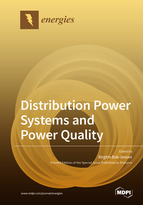Distribution Power Systems and Power Quality
A special issue of Energies (ISSN 1996-1073).
Deadline for manuscript submissions: closed (31 July 2017) | Viewed by 47217
Special Issue Editor
Interests: multienergy systems; renewables; storages; electrification of transport and heating sector; hierarchical control; demand response; grid flexibility; hosting capacity; power flow; protection in distribution grids
Special Issues, Collections and Topics in MDPI journals
Special Issue Information
Dear Colleagues,
Today, a lot of renewable power generation units such as wind power systems, photo-voltaic and small biomass fired combined heat and power plants are integrated into the power system. The first two generate power depending on the weather conditions, and therefore have fluctuating power production. Often, the last one produces power in an on–off controlled way, dependent on heat demand, which also leads to power fluctuation. Further, a lot of the new power generation units are equipped with electronic power converters, which may inject harmonics into the power system, which can also affect the power quality. What is more, at distribution level, the hosting capacity of the lines is not only affected by small, new power generation units which may lead to the voltage rising above the limit, but also large, new loads are seen in the grid, such as electrical vehicles and heat pumps, which might lead to voltages below the lower limit. These load units might also cause harmonic injections together with other converter and rectifier based loads in the grid. Another concern is the reliability of such systems; some claim that in the future we will have less interruptions due to higher possibilities for ancillary services from all the small units, but others claim that the integration of the new units will lead to more interruptions since they will replace some of the central power plants. Further, the protection system might be affected by reverse power flow and shifting short circuit level.
Therefore, this Special Issue will focus on the hosting capacity of the distribution grids, how to counteract voltage fluctuations and harmonics and how to ensure the reliability and stability of the future power system with a special focus on the distribution systems with high dispersed power generation.
Prof. Dr. Birgitte Bak-Jensen
Guest Editor
Manuscript Submission Information
Manuscripts should be submitted online at www.mdpi.com by registering and logging in to this website. Once you are registered, click here to go to the submission form. Manuscripts can be submitted until the deadline. All submissions that pass pre-check are peer-reviewed. Accepted papers will be published continuously in the journal (as soon as accepted) and will be listed together on the special issue website. Research articles, review articles as well as short communications are invited. For planned papers, a title and short abstract (about 100 words) can be sent to the Editorial Office for announcement on this website.
Submitted manuscripts should not have been published previously, nor be under consideration for publication elsewhere (except conference proceedings papers). All manuscripts are thoroughly refereed through a single-blind peer-review process. A guide for authors and other relevant information for submission of manuscripts is available on the Instructions for Authors page. Energies is an international peer-reviewed open access semimonthly journal published by MDPI.
Please visit the Instructions for Authors page before submitting a manuscript. The Article Processing Charge (APC) for publication in this open access journal is 2600 CHF (Swiss Francs). Submitted papers should be well formatted and use good English. Authors may use MDPI's English editing service prior to publication or during author revisions.
Keywords
- integration of renewable energy
- large new loads (electrical vehicles and heat pumps)
- hosting capacity
- harmonics
- voltage fluctuations
- interruptions
- flicker
- reliability
- stability






